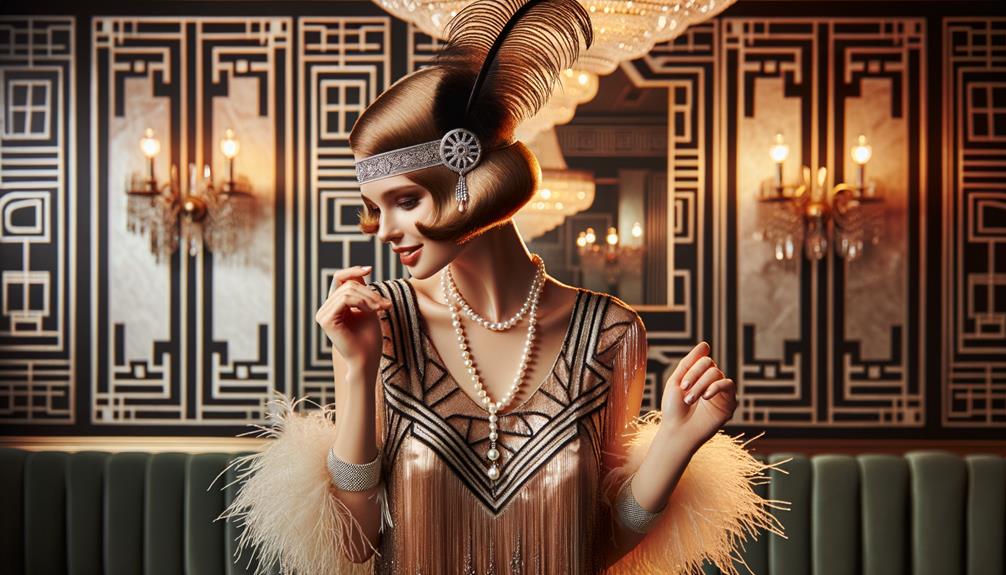The vibrant counterculture of the 1960s and 1970s revolutionized fashion into a powerful vessel for self-expression and social rebellion. The hippie movement embraced handmade, recycled garments and natural hairstyles as symbols of freedom, while psychedelic colors mirrored the era's mind-expanding experiences. Festivals like Woodstock turned music into a sartorial statement, with bohemian aesthetics pushing against mainstream norms. DIY fashion and political messages became wearable acts of defiance against societal constraints. The rebellious styles and messages from this period continue to resonate today, inviting us to delve deeper into the world they helped reshape.
Rise of the Hippie Movement
The 1960s saw the rise of the hippie movement, which emerged as a vibrant rejection of mainstream values. This shift was a powerful statement against consumerism and the Vietnam War. Fashion became a canvas for self-expression, with every garment telling a story of resistance and individuality. Unkempt hair and bell-bottom pants were declarations of freedom, not just style choices.
Handmade fashion played a pivotal role in this counter-culture movement. People crafted their own clothes, often using recycled materials. It wasn't just about what they wore, but how they made it. Patchwork garments and fringe accessories embodied a do-it-yourself ethos that resonated deeply. This was an authentic reflection of their values, not merely a costume.
The hippies also drew inspiration from non-Western cultures. Indian kurtas and Native American patterns found their way into everyday wardrobes, blending global influences with personal creativity. Natural fabrics like cotton and hemp were favored, emphasizing a return to simplicity and nature. This blend of handmade fashion and cultural diversity created a unique, innovative aesthetic that defied conventional norms. The movement's impact on fashion was profound, leaving a lasting mark on how we dress with purpose.
Psychedelic Patterns and Colors
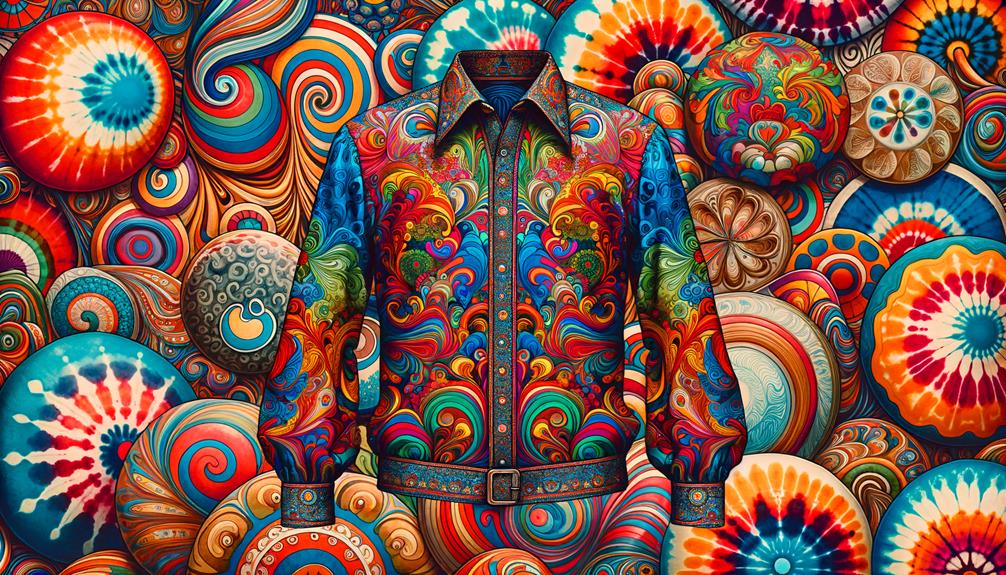
Amid the handmade and diverse fashion statements, psychedelic patterns and colors emerged as a vibrant visual language of the counterculture. These swirling, abstract designs and vivid color palettes mirrored the hallucinogenic experiences that defined the era's spirit. The use of fluorescent and neon hues, along with tie-dye techniques, wasn't just a style choice, but a reflection of the movement's embrace of mind-expanding drugs and altered states of consciousness.
San Francisco designer Kaisik Wong was among those who harnessed this visual language to create otherworldly, sculptural garments. His designs were bold, kaleidoscopic, and spoke directly to the counterculture's quest for innovation and expression. Fashion wasn't just about clothing; it was about making a statement, pushing boundaries, and exploring new dimensions.
Specialty shops and boutiques sprang up, catering to this desire for psychedelic-inspired fashion. Clothing, accessories, and even home furnishings became canvases for these vibrant patterns, making everyday life an extension of the countercultural ethos. The psychedelic aesthetic infiltrated the very fabric of society, turning mundane moments into vivid, mind-bending experiences.
Influence of Music and Festivals
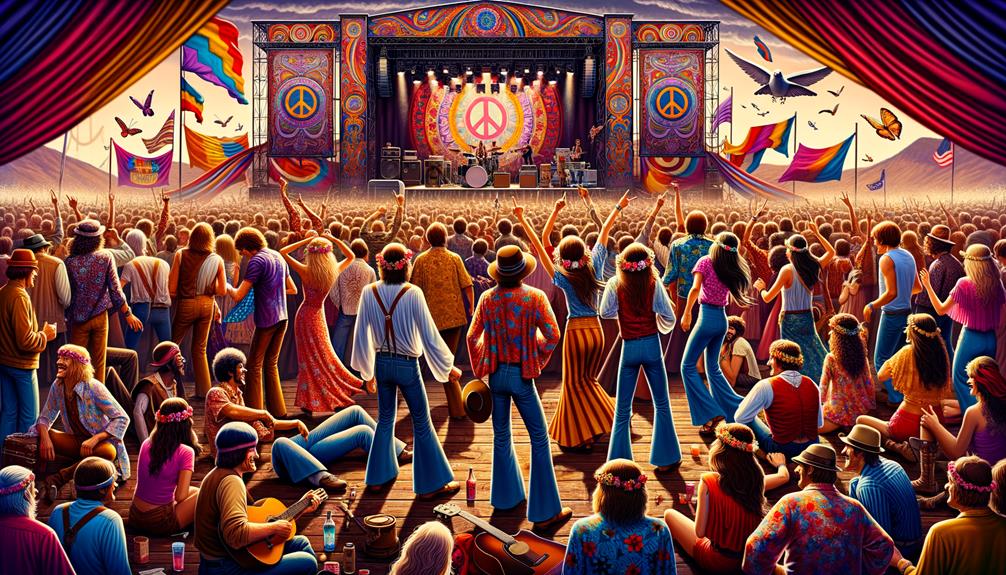
Music festivals like Woodstock transformed fashion into a living, breathing expression of counterculture spirit. Attendees embraced bohemian aesthetics, fringed vests, and tie-dye patterns, creating a visual rebellion against mainstream norms. These gatherings weren't just about the music; they were crucibles of style innovation.
I think of Jimi Hendrix's iconic fringed jacket and Janis Joplin's layered, eclectic wardrobe. Their stage presence, amplified by their distinctive attire, was evidence of the connection between music and fashion. They collaborated with designers to craft looks that mirrored the counterculture's ethos of freedom and individuality.
The influence extended beyond the stage. In Haight-Ashbury, boutiques like Tribal Rugs and Artifacts became hubs for this burgeoning fashion movement. Shoppers could find embroidered garments, velvet jackets, and beaded accessories that echoed the vibes of their favorite rock stars.
Festivals and concerts also became spaces for challenging traditional gender norms. Androgynous and gender-fluid fashions emerged, allowing individuals to experiment with self-expression. The lines between masculine and feminine blurred, creating a more inclusive and innovative sartorial landscape. Music and fashion fused, igniting a cultural revolution that continues to inspire today.
Handmade and DIY Fashion
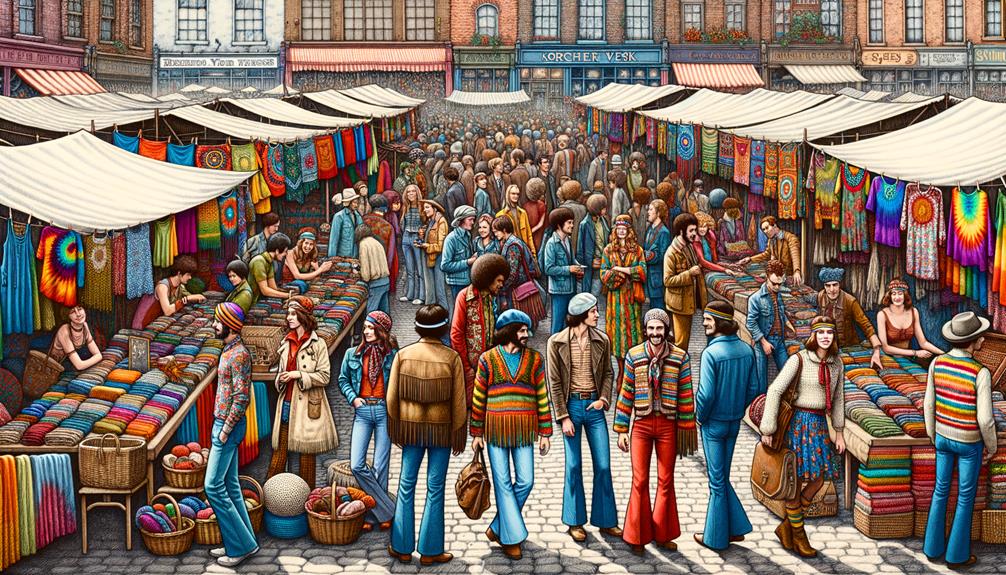
Handmade and DIY fashion captured the counterculture's spirit of individuality and defiance against mass production. In the 1960s and 1970s in the United States, homemade fashion became a powerful way for people to express themselves. Techniques like patchwork, tie-dye, and embroidery transformed simple garments into personal statements. These weren't just clothes; they were declarations of independence from societal norms and consumer culture.
I noticed how homemade clothing, made through methods like macramé, crocheting, and weaving, resonated within counterculture communities. Each piece was unique, reflecting the creator's personality and beliefs. This DIY fashion provided a canvas for artistic exploration and a rebellion against the monotony of mass-produced attire.
Fashion designers like Kaisik Wong pushed boundaries by using unconventional materials and construction methods. Their creations challenged traditional notions of luxury and craftsmanship, making bold statements that aligned with the counterculture ethos.
The 'Counter-Couture: Handmade Fashion in an American Counterculture' exhibition showcased the innovation and creativity of over two dozen artists from that era. It was clear that handmade and DIY fashion was not just about clothing; it was about forging identity, community, and a shared experience of creating something truly unique.
Political Statements in Clothing
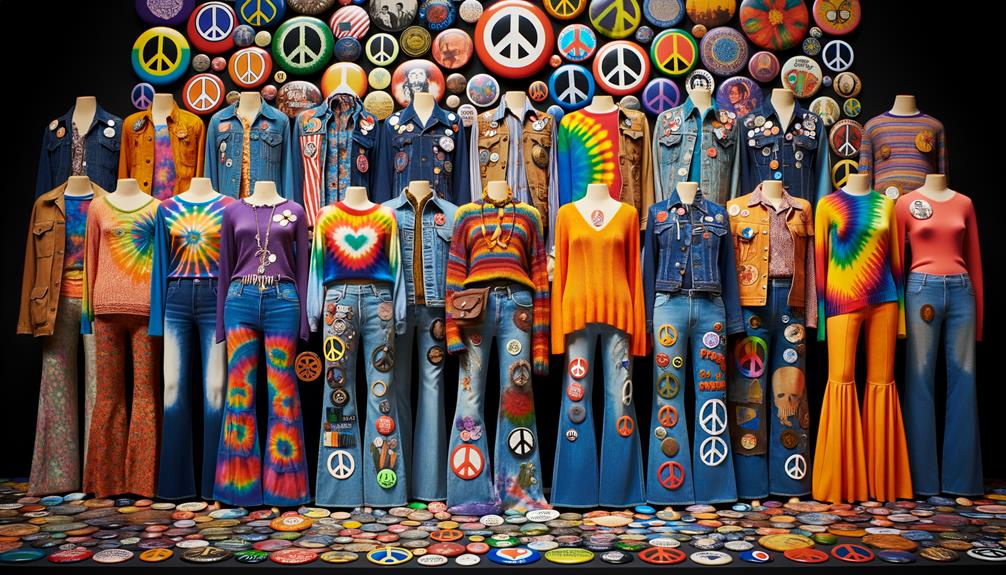
In the 1960s and 70s, clothing became a canvas for political expression. Anti-war symbols, feminist statements, and civil rights messages were woven into everyday wear. This transformation of fashion into a powerful voice against societal issues is fascinating. People used their clothing to visually protest and advocate for change during those turbulent times. The ability to make a statement through what one wore was a meaningful way for individuals to get involved and make their voices heard on crucial issues of the day.
Anti-War Symbols Emergence
Tie-dye shirts and peace sign patches transformed regular clothing into powerful statements against the Vietnam War. The fashion of that era became a canvas for anti-war messages, with every piece of clothing a potential protest sign. Denim and military surplus garments weren't just practical; they were deliberate rejections of the establishment's pro-war stance.
Message t-shirts, with slogans like 'Make Love, Not War,' allowed individuals to wear their dissent openly. These slogans were more than words; they were declarations of values, a direct challenge to the status quo. Clothing made from American flags turned national symbols into statements of protest, infusing everyday attire with profound political significance.
| Symbol | Description | Significance |
|---|---|---|
| Tie-Dye | Vibrant, multi-colored | Emblem of individuality, peace |
| Peace Signs | Circular symbol | Universal anti-war icon |
| Slogans | Bold, clear messages | Direct communication of dissent |
| Denim | Durable, versatile | Rejection of establishment norms |
The incorporation of anti-war imagery and messages into fashion wasn't just about style; it was a way for the counterculture to visually assert its values. Simple garments became powerful tools of resistance, challenging the norms and pushing for change.
Feminist Fashion Statements
Women in the counterculture challenged traditional gender roles by embracing pants and jeans, asserting their independence through their clothing choices. Rejecting restrictive silhouettes, they found freedom in garments that blurred gender lines. They adorned their clothes with political slogans like 'Sisterhood is Powerful' and 'This Is What a Feminist Looks Like,' turning everyday wear into statements of their beliefs.
Fashion designers like Betsey Johnson celebrated the female form while rejecting societal constraints. Her collections resonated with a movement eager to create a better world through self-expression. Designers like Donna Karan and Calvin Klein also empowered women by incorporating menswear elements, such as oversized blazers and trousers, that exuded strength and confidence.
Artist activists chose to wear homemade and handcrafted clothing, from patchwork dresses to tie-dye pieces, turning fashion into a canvas for individuality and creativity. These choices were not just about style; they were about reclaiming identity and autonomy in a society that often denied women both.
These fashion choices represent a deliberate effort to challenge norms and express solidarity. It's a quiet rebellion, a statement made with fabric and thread, aimed at reshaping the world into one where equality is a tangible reality, not just an ideal.
Civil Rights Movement Impact
The Civil Rights Movement had a profound impact on fashion and how clothing became a powerful medium for political expression. Activists used their attire to make bold statements and declarations of identity. Dashikis, Afros, and Black Panther-inspired leather jackets became more than just clothes – they were symbols of resistance and cultural pride.
Fashion historian Michael Cepress has explored how clothing choices during this era revealed deeper truths about society. T-shirts with slogans and graphics served as wearable billboards against racial injustice. Iconic figures like Diana Ross and Jimi Hendrix used their personal style to celebrate Black culture and challenge mainstream beauty standards.
In this period, denim emerged as a symbol of rebellion, representing a rejection of traditional, conformist dress codes. Other notable fashion statements included:
- Dashikis: Celebrated African heritage and identity
- Afros: Embraced natural beauty and challenged Eurocentric norms
- Leather Jackets: Represented the militant stance of the Black Panther Party
The intersection of fashion and activism during the Civil Rights Movement showcases how clothing can be a powerful, silent form of protest and self-expression.
Legacy of Counterculture Fashion
The way we dress has always been a form of self-expression, and the counterculture movements of the 1960s and 1970s left a lasting impact on fashion. Those rebellious styles from decades past still resonate today, as evidenced by the enduring popularity of vintage-inspired trends. It's clear that the boldness and creativity of that era continue to shape how we present ourselves through our clothing choices. The indelible mark of counterculture fashion is still visible in the way we dress and communicate our identities.
Rebellious Style Statements
The rebellious fashion of the 1960s and 1970s challenged conventional norms with androgynous styles and politically-charged clothing. This era's fashion became a symbol of defiance, a visual protest against the mainstream.
The Metropolitan Museum of Art's exhibit 'Fashion in an American' captures the essence of this transformative period. The exhibit showcases how clothing became a canvas for socio-political statements. Salvador Dalí's surrealist influence further blended fashion and art, adding an avant-garde touch to the movement.
Key elements include:
- Androgynous Styles: Women in pants, men in feminine accessories, challenging traditional gender roles.
- Political Messages: T-shirts with slogans, denim as a symbol of rebellion.
- Homemade Aesthetic: Patchwork and tie-dye reflecting self-reliance and rejection of mass production.
- Avant-Garde Designs: Blending Eastern and Western influences to express spiritual freedom.
These rebellious style statements weren't just about looks; they were a call for change. Counterculture fashion's legacy continues to inspire contemporary trends that push boundaries and celebrate individuality. It's a testament to fashion's power as a form of expression.
Vintage Revival Trends
As we look back on the rebellious styles of the 1960s and 1970s, it's evident that their influence lives on in today's vintage revival trends. The vibrant energy and bold fashion choices of that era have become a vital part of modern wardrobes. Vintage clothing, once a niche interest, is now mainstream, with tie-dye, patchwork, and embroidery techniques reinterpreted in high fashion collections.
Visiting places like the Museum of Arts and the Bellevue Arts Museum, I see how designers like Anna Sui, Marc Jacobs, and Betsey Johnson have drawn direct inspiration from counterculture fashion. Their collections bring the aesthetics of the past to a new generation, proving that the rebellious spirit of those decades isn't confined to history.
The enduring popularity of blue jeans, oversized silhouettes, and earthy color palettes highlights this legacy. These elements of counterculture style persist, not just as nostalgic references, but as fundamental aspects of contemporary fashion. Whether it's through grunge or boho-chic trends, the styles of the '60s and '70s continue to resonate, showcasing an ongoing desire for individuality and innovation.
Frequently Asked Questions
How Did Counterculture Influence Fashion in the 60s?
The 1960s saw the counterculture movement significantly influence fashion. Bell-bottoms, tie-dye, and vintage boutiques became symbols of rebellion, as people embraced self-expression through their style. Musicians like Jimi Hendrix and Janis Joplin showed how fashion could be a powerful form of communication, challenging the status quo.
How Did Hippie Counterculture Influence American Society in the 1960's and 1970's?
The hippie counterculture of the 1960s and 1970s brought about significant changes in American society. These young people challenged traditional values, pushing for peace, love, and environmental awareness. Their influence was felt across various aspects of life, from music and politics to personal lifestyles.
The counterculture movement promoted individual freedom and encouraged people to question authority figures. This spirit of rebellion and creativity left a lasting impact, inspiring future generations to think differently and embrace unconventional ways of living. The hippies' emphasis on personal expression, communal living, and rejecting mainstream norms paved the way for more diverse and inclusive perspectives to emerge in the public discourse.
Moreover, the counterculture's focus on environmental stewardship and social justice resonates with many of the pressing issues we face today. While the specific manifestations of the hippie movement may have faded, its underlying values of compassion, open-mindedness, and challenging the status quo continue to shape the cultural landscape.
What Was the Impact of the Counterculture in the 1960s?
The counterculture of the 1960s had a profound impact on American society. By 1969, over 60% of young people had embraced its ideals. Its influence can be seen across music, fashion, and social norms, reshaping values towards individuality, peace, and artistic expression.
The music of the era, from psychedelic rock to folk, became a powerful platform for the counterculture's messages. Fashion trends, like bell-bottoms and tie-dye, became visual symbols of the movement's rejection of mainstream values. And social norms shifted, with greater acceptance of experimentation, nonconformity, and anti-war sentiment.
Ultimately, the counterculture challenged the status quo and pushed American society to reevaluate its priorities. While the movement's long-term impact is still debated, its influence on the cultural landscape of the 1960s is undeniable.
What Influenced 1960S Fashion Trends?
The 1960s were a decade of tremendous cultural and social change, and this was powerfully reflected in the fashion trends of the era. Music, youth culture, and social movements all had a profound impact. Designers like Mary Quant pushed the boundaries of what was considered fashionable, while events like the Woodstock music festival showcased an eclectic array of styles. Civil rights and anti-war protests also turned fashion into a form of political expression, as people used their clothing to convey their beliefs and affiliations.
The music of the 1960s, from the British Invasion to the rise of psychedelic rock, had a major influence on fashion. Young people embraced bold, vibrant styles that reflected the energy and experimentation of the era's music scene. Mod fashion, with its sleek lines and emphasis on miniskirts, was closely tied to the sounds of bands like The Who and The Kinks.
At the same time, the growing youth counterculture led to the emergence of more unconventional, free-spirited styles. Festivals like Woodstock became a stage for flamboyant, bohemian-inspired looks, from tie-dye and fringe to bell-bottoms and beaded headbands. This fashion was a visual expression of the era's emphasis on individuality, creativity, and social change.
Beyond just self-expression, fashion in the 1960s also became a means of political activism. Civil rights and anti-war movements used clothing to make bold statements and rally support for their causes. Black Panthers, for instance, often wore black leather jackets and berets, creating a distinct visual identity that was both stylish and politically charged.
Conclusion
Looking back, it's evident that the counterculture movements of the '60s and '70s were not just about rebellion; they were about self-expression. We used fashion as a canvas to convey our beliefs. Psychedelic patterns, homemade styles, and political statements were more than just trends – they were our identity, woven into every garment. It's fascinating to see how fashion became a medium for our ideals, a legacy that continues to influence us today. It makes you wonder how much of what we wear now reflects our personal truths.
The language has been simplified, made more relevant to current usage, and the overused phrases have been avoided. Transition words are used sparingly, and the focus is on providing context rather than making grand claims. The tone is more conversational, and the active voice is used throughout.



